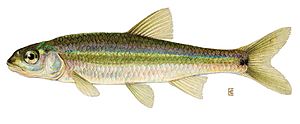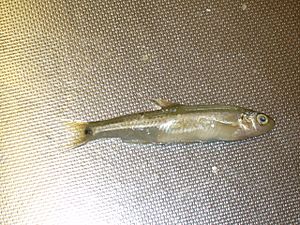Spottail shiner facts for kids
Quick facts for kids Spottail shiner |
|
|---|---|
 |
|
| Conservation status | |
| Scientific classification | |
| Synonyms | |
The spottail shiner (Notropis hudsonius) is a small freshwater fish. It is a type of minnow. You can find it in lakes, rivers, and creeks. These fish live near rocky or sandy shorelines and bottoms. A special feature of the spottail shiner is a black spot. This spot is found at the base of its tail fin. Spottail shiners usually lay their eggs in late June and July.
Contents
What Does It Look Like?
Spottail shiners are usually small to medium-sized minnows. They are about 2 to 3 inches (5.1 to 7.6 cm) long. The biggest ones can grow up to 6 inches (15 cm). They have a body that is a bit long and flat. Their mouth is horizontal and slightly underneath their snout.
The most important feature is the clear black spot. It is located at the base of their tail fin. The bottom edge of the tail fin can be white. Their other fins usually have no color. The dorsal fin (on their back) is right above their pelvic fins (on their belly). The top part of the shiner can be silver, pale green, or olive. Their belly is white. The spottail shiner also has a complete lateral line along its sides. This line helps them sense movement in the water.
Where Do They Live?
Spottail shiners mostly live in streams and rivers. But you can also find them in larger lakes. They usually live in water that is 3 to 60 feet (0.91 to 18.29 m) deep. They prefer sandy and gravelly bottoms. The spottail shiner is a common type of Notropis fish.
These shiners are native to Canada and the United States. You can find them in many places. These include the St. Lawrence River in Quebec, Canada. They are also in the Chattahoochee River in Georgia, USA. Other places are the Mackenzie River basin in Canada and the Great Lakes. They are also found in parts of Ohio, Illinois, and some lakes in Montana. It seems they have always lived in these areas. However, they were put into lakes in Montana. This was done so they could be used as bait for bigger fish like walleye.
What Do They Eat and Who Eats Them?
Spottail shiners are omnivores. This means they eat both plants and animals. They feed on plants, small water bugs, and creatures that live on the riverbed. These creatures are called zoobenthos. They eat green algae, plant pieces, water fleas, and different kinds of insect larvae. Since they are small, they usually do not eat other fish. Spottail shiners find most of their food by looking on the bottom of rivers, lakes, and streams.
Many other fish eat spottail shiners. This is because spottail shiners are small. Some of their predators include rainbow trout, coho salmon, and chinook salmon. Other predators are northern pike, walleye, brown trout, and lake trout. Even bluefish will eat them.
Spottail shiners also compete for food and space. They compete with other fish that eat the same things. These can be other types of shiners, or fish like yellow perches.
The water they live in is important. Spottail shiners are most active in water with a pH between 5.6 and 6.6. They like a pH of about 6.1 the best. They generally live in water that is 10 to 50 °C (50 to 122 °F).
Life Cycle and Reproduction
Scientists have not studied the life cycle of the spottail shiner very much. Their breeding season is usually in the summer. This happens during June and July. They are thought to lay their eggs on the sandy bottoms and shorelines. These are the same places where they live.
A female spottail shiner can lay between 100 and 2,600 eggs at one time. They become adults and can reproduce when they are about one or two years old. The oldest spottail shiner ever recorded lived for 5 years. Because there hasn't been much research, we don't know a lot about their spawning and how they reproduce.
Protecting Spottail Shiners
Currently, spottail shiners are listed as "least concern." This means they are not in danger of disappearing yet. The main reasons they die are being eaten by other fish, water pollution, and parasites.
Minnows like the spottail shiner are often caught to be used as bait. People use them to catch bigger game fish. Their shiny scales and small bodies attract certain fish. Because of this, some states have agencies that protect these shiners. They try to stop too many from being caught for bait.
Pollution from chemicals and wastewater also harms them. These pollutants can weaken the immune system of spottail shiners. Some parasites can also affect their immune system and health.
See also
 In Spanish: Notropis hudsonius para niños
In Spanish: Notropis hudsonius para niños



